Sega had very close ties with Disney throughout the Genesis’ life span and beyond, releasing numerous games in the process with some of Disney’s most beloved characters of the time. This article is going to go through those games in chronological order and see how each game progressed and got classified into a sort of series of its own. Also included are Master System and Game Gear counterparts and other games.
Castle of Illusion
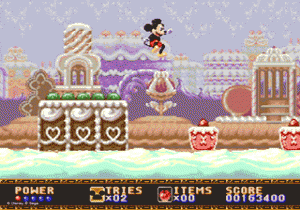 Let’s start off with the first Disney game from Sega, one of the games that actually lured us to the Genesis early on before the release of Sonic The Hedgehog: Castle of Illusion. Released in 1990 as one of the Genesis’ early first-party platformers designed by Sega of Japan, it combined the charm and look of Mickey Mouse with an extremely fun platformer game for the Genesis. It was part of the “Genesis Does” campaign as well, gaining its own commercial with the likes of Moonwalker, Strider, and Shadow Dancer. Castle of Illusion started off the Illusion brand of Disney games made by Sega that had releases on Sega CD, Master System, and Game Gear.
Let’s start off with the first Disney game from Sega, one of the games that actually lured us to the Genesis early on before the release of Sonic The Hedgehog: Castle of Illusion. Released in 1990 as one of the Genesis’ early first-party platformers designed by Sega of Japan, it combined the charm and look of Mickey Mouse with an extremely fun platformer game for the Genesis. It was part of the “Genesis Does” campaign as well, gaining its own commercial with the likes of Moonwalker, Strider, and Shadow Dancer. Castle of Illusion started off the Illusion brand of Disney games made by Sega that had releases on Sega CD, Master System, and Game Gear.
Following the success of the Genesis version, the game was ported to Master System and then to Game Gear in 1991. What many people don’t know is that the Master System/Game Gear and Genesis versions of Castle of Illusion are actually very different games. They both look rather similar and contain the same types of levels (forest, library, etc.) throwing people off in the process, but they are actually extremely different in terms of level layout. The bosses are also different as well.
Castle of Illusion for Master System/Game Gear then got a sequel in 1992 called Land of Illusion for Master System and Game Gear. In Land of Illusion, Mickey falls asleep while reading fairy tales and ends up waking up in a strange village. A woman that looks like Daisy Duck finds him and tells him that a phantom has stolen the crystals from the villagers and there has only been sadness since then, no joy. So Mickey decides to help the villagers (who look like various main Disney characters such as Goofy and Minnie) and goes after the phantom to regain the crystals for the villagers.
Quackshot Starring Donald Duck
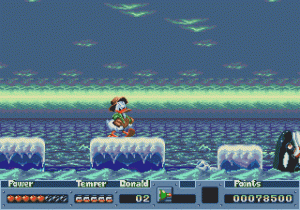 Next up is Quackshot, released in 1991 and designed by Sega of Japan. Quackshot put Donald Duck and his three nephews Huey, Dewey, and Louie in an Indiana Jones-esque role as he travels the world using a map he found in Uncle Scrooge’s library that leads to treasure. He goes to many different places including Duckberg, Mexico, India, and Transylvania. Quackshot’s gameplay is different from Castle of Illusion’s, as instead of jumping on enemies to destroy them, it adds a shooting element (along with the famous duck’s trademark temper!). Donald shoots plungers, popcorn, and other forms of ammo to stun and defeat his enemies along the way.
Next up is Quackshot, released in 1991 and designed by Sega of Japan. Quackshot put Donald Duck and his three nephews Huey, Dewey, and Louie in an Indiana Jones-esque role as he travels the world using a map he found in Uncle Scrooge’s library that leads to treasure. He goes to many different places including Duckberg, Mexico, India, and Transylvania. Quackshot’s gameplay is different from Castle of Illusion’s, as instead of jumping on enemies to destroy them, it adds a shooting element (along with the famous duck’s trademark temper!). Donald shoots plungers, popcorn, and other forms of ammo to stun and defeat his enemies along the way.
Quackshot also got a port to Master System and Game Gear called The Lucky Dime Caper, but it wasn’t as direct as Castle of Illusion, it was more in the vein of a spin-off game. In The Lucky Dime Caper, Magica De Spell has kidnapped Huey, Dewey, and Louie and stolen Uncle Scrooge’s Number One Dime. Donald must go around the world to save his nephews and recover Scrooge’s most precious dime.
The Lucky Dime Caper also got a sequel game called Deep Duck Trouble, released for Game Gear and Master System in 1993. Uncle Scrooge has turned into a balloon due to a curse. Donald must go around the world again and find a cure for Uncle Scrooge. An interesting thing to point out here is that Lucky Dime Caper and Deep Duck Trouble actually play more similarly to Castle of Illusion rather than Quackshot.
Fantasia
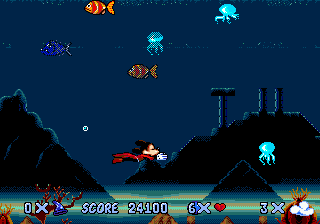 In 1991, Fantasia was released by Sega and developed by Infogrames. In Fantasia, you play as Sorcerer Mickey in his role from the Fantasia movie. Since this game was developed by Infogrames and not Sega, it is not considered part of the Illusion series, and is also considered the weakest game featuring the iconic mouse. While it looks better and sounds better than the other Disney games, the gameplay is sub-par and the storyline is not as written-out as the other titles. Sega’s own Ken Balthaser admitted to the game’s rushed development and how poorly it played. Disappointing, to be sure, because if ever there was a property to treat with special love and care, this was it.
In 1991, Fantasia was released by Sega and developed by Infogrames. In Fantasia, you play as Sorcerer Mickey in his role from the Fantasia movie. Since this game was developed by Infogrames and not Sega, it is not considered part of the Illusion series, and is also considered the weakest game featuring the iconic mouse. While it looks better and sounds better than the other Disney games, the gameplay is sub-par and the storyline is not as written-out as the other titles. Sega’s own Ken Balthaser admitted to the game’s rushed development and how poorly it played. Disappointing, to be sure, because if ever there was a property to treat with special love and care, this was it.
World of Illusion
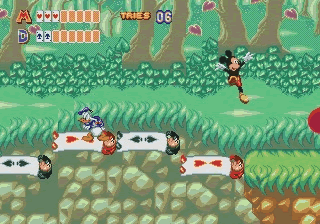 In 1992, Sega of America released World of Illusion, where, during a magic show for their friends, Donald and Mickey accidentally go through a magical door planted by Pete that leads to another world. They have to go through different levels using their magic capes to get home again. This is considered the point where the two different Disney franchises made by Sega meet up. It is also the last Disney game in the Illusion franchise on the Genesis. The Disney Illusion series is considered by many to be one of the best and most memorable franchises on the Genesis, second only to the Sonic The Hedgehog series.
In 1992, Sega of America released World of Illusion, where, during a magic show for their friends, Donald and Mickey accidentally go through a magical door planted by Pete that leads to another world. They have to go through different levels using their magic capes to get home again. This is considered the point where the two different Disney franchises made by Sega meet up. It is also the last Disney game in the Illusion franchise on the Genesis. The Disney Illusion series is considered by many to be one of the best and most memorable franchises on the Genesis, second only to the Sonic The Hedgehog series.
Fans most notably remember the simultaneous cooperative play that World of Illusion offered, and it’s lamentable that Sega didn’t revisit this dynamic later on.
Legend of Illusion
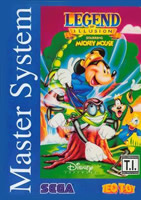 The final game in the Illusion series is Legend of Illusion released in 1995 for the Game Gear. In Legend of Illusion you play as Mickey, who is a laundry boy in an outfit not unlike the one he wears in The Little Tailor cartoon, going through a kingdom ruled by Pete. Pete sends Mickey out to find the Water of Life after a shadow threatens the lives of the kingdom. Pete is too cowardly to go himself, so he sends Mickey instead. Mickey goes through different castles such as Castle Goofenstien looking for the Water of Life. This game is actually rather uncommon as it was released very late in the Game Gear’s life span and is relatively unknown. It plays and looks in the same vein as Land of Illusion. Many Mickey fans feel it’s the superior version of the two Castle games, and the debate as to which is better rages furiously to this day.
The final game in the Illusion series is Legend of Illusion released in 1995 for the Game Gear. In Legend of Illusion you play as Mickey, who is a laundry boy in an outfit not unlike the one he wears in The Little Tailor cartoon, going through a kingdom ruled by Pete. Pete sends Mickey out to find the Water of Life after a shadow threatens the lives of the kingdom. Pete is too cowardly to go himself, so he sends Mickey instead. Mickey goes through different castles such as Castle Goofenstien looking for the Water of Life. This game is actually rather uncommon as it was released very late in the Game Gear’s life span and is relatively unknown. It plays and looks in the same vein as Land of Illusion. Many Mickey fans feel it’s the superior version of the two Castle games, and the debate as to which is better rages furiously to this day.
But Legend of Illusion would not be the last seen of the famous Illusion series made by Sega. In 1996, Sega released Castle of Illusion, along with Quackshot, on a single cartridge in Europe. The Japanese Saturn received an exclusive single-disc compilation of the two games in 1998 called Sega Ages: Mickey Mouse & Donald Duck.
Icons for the Ages
In Conclusion, Sega took the most beloved cartoon characters in history and turned them into one of the most beloved video game series in video game history and released them on Sega Genesis, Master System, and Game Gear. All these games I recommend highly, and if you haven’t played at least one or two of these games, you need to go out and buy some of them as soon as possible! The games are easy to find, cheap, and extremely well-made. They help make up a very large portion of the Sega Genesis’ well-built first party library. These games will last for years to come, they are so good.

Recent Comments